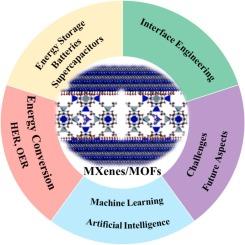界面和表面工程:MXenes, mof和AI在能量存储/转换混合材料设计中的关系
IF 22
1区 材料科学
Q1 MATERIALS SCIENCE, MULTIDISCIPLINARY
引用次数: 0
摘要
具有可调性能的杂化材料,特别是金属有机框架(MOFs)和MXene复合材料,已成为储能和转换系统的前沿研究领域。这些杂化材料的电化学性能取决于几个关键因素,包括mof的固有特性、合成方法、结构形态以及先进的界面工程技术,如化学改性、杂化和表面掺杂。这些策略显著提高了电导率、稳定性、离子传输和电荷转移效率,使MOF@MXene复合材料在超级电容器、电池以及析氢反应(HER)和析氧反应(OER)等能量转换过程中的应用非常有效。此外,人工智能(AI)和机器学习(ML)技术,包括深度学习、遗传算法、贝叶斯优化、支持向量机(SVM)、随机森林和密度泛函数理论(DFT)辅助的ML模型,通过预测理想的材料组合、改进合成方法和指导设计,在优化MXene和MOF界面方面发挥了重要作用。MXenes、mof和AI的结合凸显了MOF@MXene复合材料在塑造可持续能源未来方面的巨大潜力。本文章由计算机程序翻译,如有差异,请以英文原文为准。

Interface and surface engineering: The nexus of MXenes, MOFs, and AI in hybrid material design for energy storage/conversion
Hybrid materials with tunable properties, particularly metal–organic frameworks (MOFs) and MXene composites, have become a forefront research area in energy storage and conversion systems. The electrochemical performance of these hybrids is governed by several critical factors, including the intrinsic characteristics of MOFs, synthesis methods, structural morphology, and advanced interface engineering techniques such as chemical modification, hybridization, and surface doping. These strategies significantly enhance conductivity, stability, ion transport, and charge transfer efficiency, making MOF@MXene composites highly effective for applications in supercapacitors, batteries, and energy conversion processes like hydrogen evolution reaction (HER) and oxygen evolution reaction (OER). Furthermore, artificial intelligence (AI) and machine learning (ML) techniques including deep learning, genetic algorithms, Bayesian optimization, support vector machines (SVM), random forest, and density functional theory (DFT)-assisted ML models play an important role in optimizing MXene and MOF interfaces by predicting ideal material combinations, refining synthesis methods, and guiding design. This nexus of MXenes, MOFs, and AI highlights the immense potential of MOF@MXene composites in shaping a sustainable energy future.
求助全文
通过发布文献求助,成功后即可免费获取论文全文。
去求助
来源期刊

Materials Today
工程技术-材料科学:综合
CiteScore
36.30
自引率
1.20%
发文量
237
审稿时长
23 days
期刊介绍:
Materials Today is the leading journal in the Materials Today family, focusing on the latest and most impactful work in the materials science community. With a reputation for excellence in news and reviews, the journal has now expanded its coverage to include original research and aims to be at the forefront of the field.
We welcome comprehensive articles, short communications, and review articles from established leaders in the rapidly evolving fields of materials science and related disciplines. We strive to provide authors with rigorous peer review, fast publication, and maximum exposure for their work. While we only accept the most significant manuscripts, our speedy evaluation process ensures that there are no unnecessary publication delays.
 求助内容:
求助内容: 应助结果提醒方式:
应助结果提醒方式:


